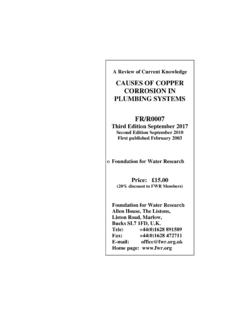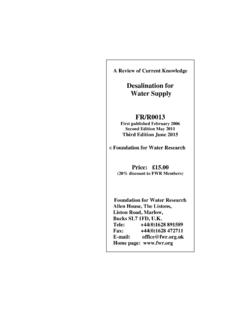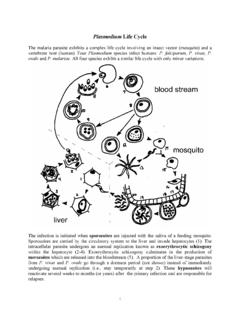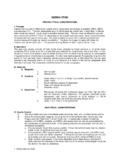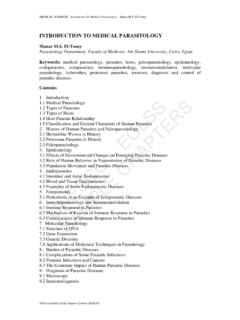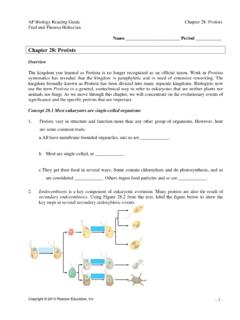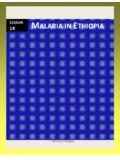Transcription of CRYPTOSPORIDIUM in WATER SUPPLIES FR/R0005
1 A Review of Current Knowledge CRYPTOSPORIDIUM in WATER SUPPLIES FR/R0005 First published November 2001 Second edition September 2006 Third Edition December2011 Foundation for WATER Research Price: (20% discount to FWR Members) Foundation for WATER Research Allen House, The Listons, Liston Road, Marlow, Bucks SL7 1FD, Tele: +44(0)1628 891589 Fax: +44(0)1628 472711 E-mail: This review is one of a series of Reviews of Current Knowledge (ROCKs)produced by FWR. They focus on topics related to WATER supply,wastewater disposal and WATER environments, which may be the subject ofdebate and inquiry. The objective of each review is to produce concise,independent scientific and technical information on the subject tofacilitate a wider understanding of the issues involved and to promoteinformed opinion about them.
2 Foundation for WATER Research 2011 Copyright Apart from any fair dealing for the purposes of research or private study, or criticism or review, as permitted under the UK Copyright, Designs and Patents Act (1998), no part of this publication may be reproduced, stored or transmitted in any form or by any means, without the prior permission in writing of FWR. Disclaimer Whilst every effort has been made to ensure accuracy FWR will not accept responsibility for any loss or damage suffered by any person acting or refraining from acting upon any material contained in this publication. Appropriate professional advice should be sought when making important decisions to ensure the information is correct, up-to-date and applicable to specific circumstances. Review of Current Knowledge CRYPTOSPORIDIUM in WATER SUPPLIES CRYPTOSPORIDIUM protozoan Cover page image Science Photo Library Author: R Clayton Third Edition revised by Laura Keay 1 Review of Current Knowledge CONTENTS Page 1 Introduction 3 2 What is CRYPTOSPORIDIUM and Cryptosporidiosis?
3 4 3 CRYPTOSPORIDIUM in the environment 5 4 The life - cycle of CRYPTOSPORIDIUM 7 5 Cryptosporidiosis in the community 7 6 Outbreaks of Cryptosporidiosis 7 7 Can all oocysts cause an infection? 8 8 How are oocysts detected in WATER SUPPLIES ? 9 9 How do we prevent CRYPTOSPORIDIUM entering WATER SUPPLIES ? 9 10 Summary 13 References 14 2 Review of Current Knowledge 1 Introduction Most developed countries have regulations which specify a minimum quality for public and private drinking WATER SUPPLIES . This is to ensure that the WATER is both pleasant and safe to drink. In the European Union (EU) the quality required in member states for public SUPPLIES of drinking WATER was first specified in 1980 by the Drinking WATER Directive.
4 The Directive defined limits for the chemical and microbiological content of the drinking WATER . A revised EU Directive was approved in 1998 (EU Council Directive 98/83/EC) which has been implemented in the UK by means of Statutory Instruments (SI) which define drinking WATER regulations. The overall requirement for drinking WATER is that it shall be "Wholesome". This is defined in the regulations as " WATER which does not contain any micro-organism or parasite or any substance at a concentration or value which would constitute a danger to human health". Further information is available from the website of the Drinking WATER Inspectorate (for England & Wales) at Small WATER reservoir below Malvern Hills. R G Ainsworth In the UK WATER companies are required to carry out risk assessments on all their WATER supply sites to ascertain the level of risk CRYPTOSPORIDIUM poses to the final treated WATER quality.
5 Those at high risk need additional treatment (in the form of properly controlled coagulation/flocculation filtration systems or membrane or UV treatment systems (see section 9)). The UK regulations also require WATER 3 Review of Current Knowledge companies to design and continuously operate adequate treatment and disinfection. A proven failure to comply with this is now an offence. The current WATER Supply ( WATER Quality) Regulations 2000 were amended in 2007 (SI 2000 No. 3184) to remove Section 29, the requirements previously in place to monitor all treated WATER SUPPLIES for CRYPTOSPORIDIUM . Whereas previously the regulations had been very specific (continuous monitoring of high risk sites post treatment to achieve <1 oocyst per 10 litres) they now only require WATER companies to produce WATER which is Wholesome with regard to CRYPTOSPORIDIUM (Regulation 4).
6 An oocyst is the infective form of the parasite CRYPTOSPORIDIUM and is later described in this review. Other potential parasites are found in surface waters, notably Giardia. A wide range of parasites can cause disease (for example malaria is caused by the parasite Plasmodium and sleeping sickness is caused by the parasite Trypanosoma). A number of parasites (or their infective form) are found in lakes, rivers, and groundwaters and if they are ingested when the WATER is drunk illness can follow. Entamoeba histolytica, which is principally a tropical parasite causing amoebic dysentery, is the third largest cause of parasitic death in human beings after malaria and schistosomiasis. The American WATER Works Association Manual on Waterborne Pathogens (AWWA, 2006) lists at least 18 different waterborne parasites most of which are found principally in tropical climates. The waterborne parasites of greatest concern in countries with temperate climates are CRYPTOSPORIDIUM and Giardia.
7 This review provides specific information on CRYPTOSPORIDIUM , a parasite which causes an unpleasant illness and which is well known for its resistance to drug therapy in infected animals and human beings and its resistance to the normal methods used to disinfect drinking WATER . Another review in this series addresses Giardia (FWR, 2006). 2 What is CRYPTOSPORIDIUM and Cryptosporidiosis? CRYPTOSPORIDIUM is a waterborne parasite found widely distributed around the world including Europe. When ingested it can cause an unpleasant illness called cryptosporidiosis. Infection is transmitted by tiny spore- or egg-like cells called oocysts. These oocysts are small, roughly spherical in shape and about 4 to 6 m in diameter; a m is a micrometre, one millionth of a metre. 4 Review of Current Knowledge Surface of the small intestine infected with CRYPTOSPORIDIUM parvum parasites.
8 Moredun Scientific Ltd / Science Photo Library The symptoms of cryptosporidiosis are diarrhoea (92% of patients), mild abdominal pain (45% of patients), nausea and vomiting (51% of patients), mild fever (63% of patients) and incubation period of the disease is between 4 and 28 days with an average of 7 days. Specific antibiotics can be used to treat the illness if diagnosed correctly however recovery from the illness is usually dependent on the body's immune system alone. As a consequence cryptosporidiosis may be very serious in people whose immune system is weakened or less effective such as the very young, the elderly, AIDS sufferers and those on immuno-suppressant drugs. Although the disease is not usually fatal it can be life -threatening for individuals with weakened immune systems. 3 CRYPTOSPORIDIUM in the environment CRYPTOSPORIDIUM is found in man and many other mammals and also in birds, reptiles and fish.
9 It is principally an infection of new-born and young animals except in man in which it can readily infect all ages. Although known as a cause of sickness in farm animals it was not recognised as a causative agent of illness in man until 1976 (Casemore et al, 1985). Oocysts are passed in the faeces of infected animals, including humans. Typically, an infected calf can excrete ten thousand million oocysts daily for up to 10 days. Infection occurs either by zoonosis (animal-person contact), by ingestion of contaminated food and drink, or by inhalation of droplets contaminated with oocysts ( from farm animals). 5 Review of Current Knowledge A UK survey (Carrington & Smith, 1995) found that between 37% and 74% of samples of treated sewage from 14 plants in the UK contained oocysts. Rivers into which treated sewage is discharged are thus likely to contain oocysts. Groundwater can also become contaminated with oocysts.
10 In 1993 an outbreak of cryptosporidiosis in the UK was associated with a borehole supply (Morgan et al, 1995) and other studies have also shown that groundwaters can be contaminated by both CRYPTOSPORIDIUM and Giardia (Hancock et al, 1997). Swimming pools are also potential sources of oocysts and infection (DWI, 2000; Puech et al, 2001). There are many different species of CRYPTOSPORIDIUM found in animals (DWI, 2004). Some species are adapted to infecting several hosts - for example CRYPTOSPORIDIUM parvum infects both human beings and ruminant animals (Chalmers et al, 1995). Other species are more host specific, for example CRYPTOSPORIDIUM hominus is largely confined to human beings. The oocysts of CRYPTOSPORIDIUM are passed in huge quantities in the faeces of infected people and animals (which is why oocysts are found in sewage effluent and sewage sludge).

